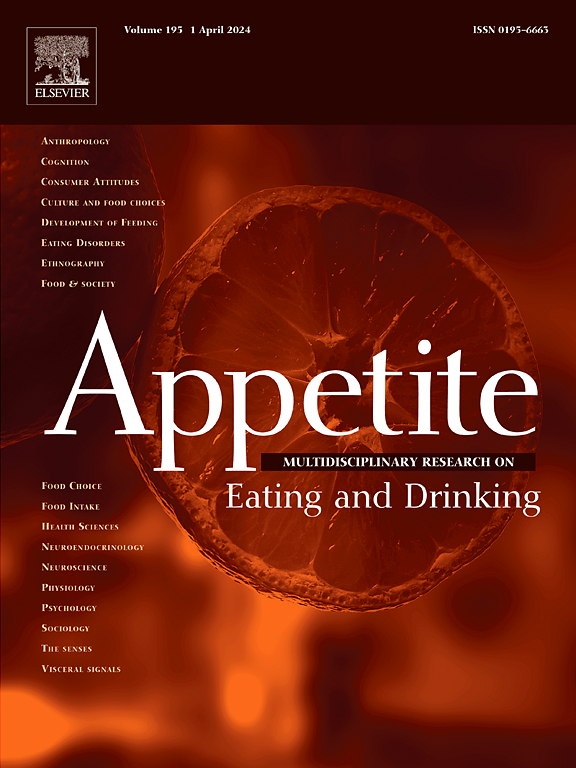A mesocorticolimbic insulin receptor gene co-expression network moderates the association between early life adversity and food approach eating behaviour style in childhood
IF 4.6
2区 医学
Q1 BEHAVIORAL SCIENCES
引用次数: 0
Abstract
Insulin receptors, located in brain regions associated with reward sensitivity and decision-making, facilitate insulin action in the brain, modulating intracellular signaling cascades, gene expression, and neural activity. Here, we tested if variations in the expression of the insulin receptor gene network in the prefrontal cortex (PFC) and striatum (STR) moderate the association between early life adversity and eating behaviour in childhood and if this moderation is sex-specific. Participants from the Maternal Adversity, Vulnerability and Neurodevelopment (MAVAN) and Basal Influences on the Baby's Development (BIBO) were included as two independent cohorts. A biologically-informed polygenic score reflecting functional variation of the mesocorticolimbic insulin receptor gene network was created by using insulin receptor co-expression data from the PFC and STR in mice, and validated in humans through filtering by homologous expression in PFC using well-known databases. Early life adversity exposure was measured as a composite score. Eating behaviour was characterized using the Child Eating Behaviour Questionnaire administered to mothers of children aged 4 and 6 years in MAVAN, and 6 years in BIBO. We found that only in those with high expression of the mesocorticolimbic insulin receptor gene network a higher early adversity score associated with a higher desire to drink in 4-year boys and 6-year girls, as well as a higher food approach score and food approach/food avoidance ratio in 4-year girls. Also, a higher early life adversity was associated with higher food responsiveness, food approach score and food approach/food avoidance ratio at 6 years in the MAVAN full sample. The moderation observed on desire to drink was partially replicated in BIBO children aged 6 years. Identifying individual differences in response to early adversity may help to prioritize individuals at high risk for long-term disease and design suitable interventions.
中脑皮质边缘胰岛素受体基因共表达网络调节了早期生活逆境与童年期饮食行为方式之间的关系。
胰岛素受体位于与奖赏敏感性和决策相关的大脑区域,可促进胰岛素在大脑中的作用,调节细胞内信号级联、基因表达和神经活动。在此,我们测试了胰岛素受体基因网络在前额叶皮层(PFC)和纹状体(STR)中的表达变化是否会调节早期生活逆境与儿童期饮食行为之间的关系,以及这种调节是否具有性别特异性。研究人员将母亲逆境、脆弱性和神经发育(MAVAN)和婴儿发育基础影响(BIBO)的参与者作为两个独立队列纳入研究。利用小鼠皮质中枢和STR的胰岛素受体共表达数据,建立了反映皮质中脑边缘胰岛素受体基因网络功能变异的生物信息多基因评分,并利用知名数据库通过筛选皮质中枢的同源表达对人类进行了验证。早期生活逆境以综合评分的形式进行测量。在MAVAN调查中,对4岁和6岁儿童的母亲进行了儿童饮食行为问卷调查;在BIBO调查中,对6岁儿童的母亲进行了儿童饮食行为问卷调查。我们发现,只有在中皮质边缘胰岛素受体基因网络高表达的儿童中,早期逆境得分越高,4 岁男孩和 6 岁女孩的饮酒欲望越高,4 岁女孩的食物接近得分和食物接近/食物回避比率也越高。此外,在 MAVAN 全部样本中,早期生活逆境较高与 6 岁时较高的食物反应性、食物接近得分和食物接近/食物回避比率有关。在 6 岁的 BIBO 儿童中,观察到的对饮酒欲望的调节作用也部分存在。确定个体对早期逆境反应的差异可能有助于优先考虑长期患病的高风险个体,并设计合适的干预措施。
本文章由计算机程序翻译,如有差异,请以英文原文为准。
求助全文
约1分钟内获得全文
求助全文
来源期刊

Appetite
医学-行为科学
CiteScore
9.10
自引率
11.10%
发文量
566
审稿时长
13.4 weeks
期刊介绍:
Appetite is an international research journal specializing in cultural, social, psychological, sensory and physiological influences on the selection and intake of foods and drinks. It covers normal and disordered eating and drinking and welcomes studies of both human and non-human animal behaviour toward food. Appetite publishes research reports, reviews and commentaries. Thematic special issues appear regularly. From time to time the journal carries abstracts from professional meetings. Submissions to Appetite are expected to be based primarily on observations directly related to the selection and intake of foods and drinks; papers that are primarily focused on topics such as nutrition or obesity will not be considered unless they specifically make a novel scientific contribution to the understanding of appetite in line with the journal's aims and scope.
 求助内容:
求助内容: 应助结果提醒方式:
应助结果提醒方式:


